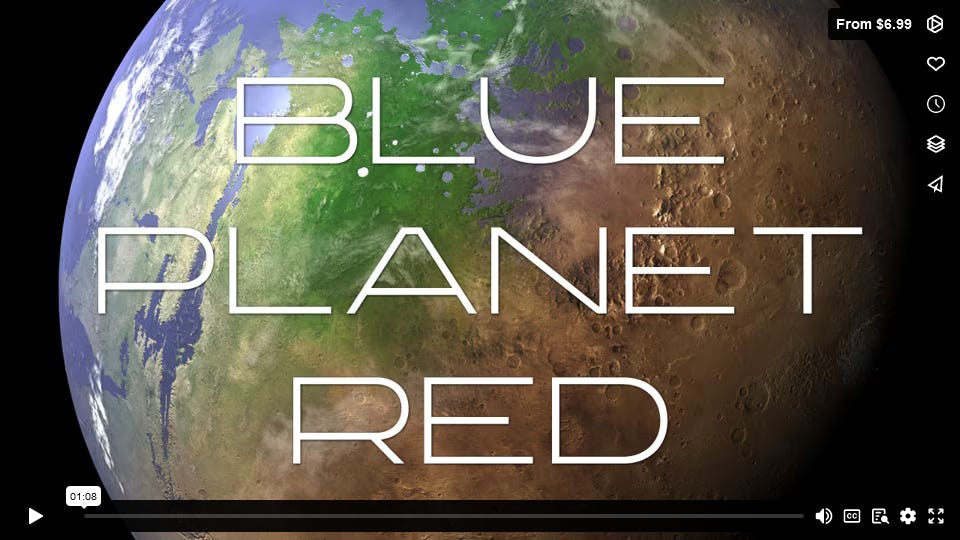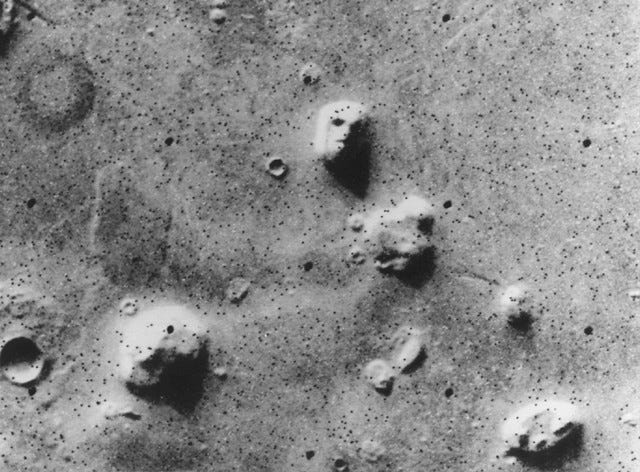My Life on Mars - Blue Planet Red
New Documentary Features my Commentary on the Search for Life.
My ever-patient wife, Kathy, once said, “Many husbands go fishing or hunting. My husband goes to Mars.” Obviously, the Red Planet is a little farther from Earth than 30,000 feet. It is about 34 million miles or 54.6 million kilometers at their closest approach, which depends on the positions of the planets in their elliptical orbits. By comparison, the Sun is “only” 92 million miles away or 150 million kilometers from earth. It takes about 3 minutes for a light signal to travel from Earth to Mars.
My first trip began in the early 1980’s when I was asked to look at some Viking mission images of a face and pyramids on the surface of Mars. I was told that they needed an anthropologist immediately, which is a little odd since anthropologists usually arrive fashionably late by at least two hundred years. Since then, I have worked with a wide variety of scientists over the years as the exploration of Mars has continued. Many of the things that our group had thought about, such as Mars being an earth-like planet, have become a standard part of science.
Check out this video by Brian Dobbs which includes some short pieces of commentary by me about the reluctance of the scientific community to talk about life on Mars and the public’s fascination with it.
For the trailer, click on the link below.
https://vimeo.com/ondemand/blueplanetred/886669069?autoplay=1
Blue Planet Red take a broad look at the natural history of Mars from being a blue marble planet like earth to its current state as a red, barren, cold desert. The scientists and engineers who have spent their careers studying Mars have lengthy credentials and reams of scientific papers and patents. The film features several scenes with comments from people on the street about Mars. While it does focus on scientific facts and controversies, it is not deadly serious. It is somewhat playful and brings out the human side of researchers and Mars enthusiasts.
The film begins by dealing with life in the universe as something that spreads by meteors carrying the essential building blocks of life. It posits that life on earth and Mars probably had the same source. Meteorites on earth have come from Mars. Well-qualified experts, many of whom have been affiliated with the National Aeronautics and Space Administration, talk about proof of microbial life on Mars and fossils of ancient Martian life forms.
Alas, there is no evidence of little green people. But are there the remains of an ancient civilization? This was the topic of my book, The Face on Mars- Evidence of a Lost Civilization? (Chicago Review Press, 1986). Dr. Mark Carlotto, a world class imaging specialist, makes a strong case that various features on the surface of Mars do not appear to be natural formations.
Of special interest are theories to explain the massive damage to the surface of the planet and theories about how Mars lost its atmosphere. Theories range from massive electric discharges brought about by interaction with earth or even some type of catastrophe involving nuclear weapons, based on the number and types of isotopes that are characteristic of nuclear explosions.
The filmmakers decided to use my footage to talk about what discovering another intelligent life form would mean for us as a species and what it would mean if we never discover one. According to Arthur C. Clarke, both options are very disturbing. The search for life and out though experiments in science fiction are really a quest to find out who we are and what we might become in the future. I also say that the catastrophe that Mars suffered and its transition from a blue planet to a red planet is a cautionary tale for us
Elon Musk will be taking us to Mars. He sees it as a refuge for humanity in the event of a nuclear holocaust or other planetary disaster. Other individuals and groups have also been preparing and advocating for settling Mars. Some have additionally proposed terra-forming or making it earthlike. This would involve building up the magnetic field, the atmosphere, and raising the temperature.
Most people agree with the memorable lyrics of Bernie Taupin set to Elton John’s 1972 composition Rocket Man. "Mars ain't the kind of place to raise your kids.” It is cold and uninviting, without much of an atmosphere.
The Martian, by Andy Weir, is a riveting story of an astronaut left behind on the surface of Mars and his survival in a hostile environment. More than likely, human settlements would be largely underground in huge caverns with their own self-contained air and underground water supplies.
When I began my trips to Mars in 1983, I knew that it would take decades to get the information we needed to understand life on Mars. At that time, there was a lot of opposition to the idea that there was liquid water on Mars, even though the planet has ice caps. There was a lot of opposition to the notion that there had been ancient sea beds and coast lines, which I and others could see in the images from the Viking Mission. Forty years later, the scientific evidence is stacking up. Images of the Face and the pyramids in the Cydonia region of Mars have been rejected as natural landforms based on subsequent images from other probes. However, if scientific imaging specialists like Dr. Mark Carlotto are vindicated, our notion of an ancient civilization may gain a lot of traction.
Stay tuned.
Now we return to our regular program at a grounded 30,000 feet.
_________________
Thanks to all my readers for your support. I have received many good comments by email. Please feel free to share your comments here.
I would like to thank all of you who have subscribed. It’s a great help to me since I can see who is receiving the posts and how you are responding.





